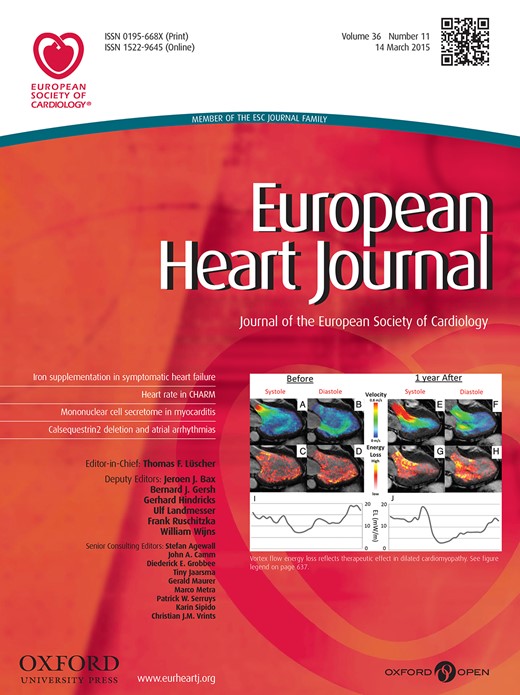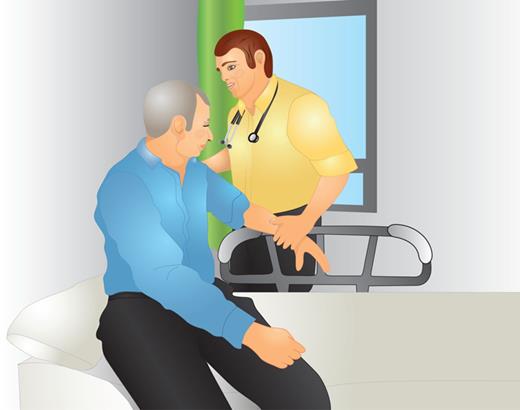-
PDF
- Split View
-
Views
-
Cite
Cite
Michel Komajda, Heart rate in chronic heart failure: an overlooked risk factor, European Heart Journal, Volume 36, Issue 11, 14 March 2015, Pages 648–649, https://doi.org/10.1093/eurheartj/ehu440
Close - Share Icon Share
This editorial refers to ‘Prognostic importance of temporal changes in resting heart rate in heart failure patients: an analysis of the CHARM program’†, by A. Vazir et al., on page 669.
Introduction
Heart rate measured by palpation and more recently by auscultation has been used for centuries to assess the cardiovascular condition of patients (Figure 1). It is, however, only recently that the importance of heart rate measurement as a prognostic factor has been recognized in unselected healthy populations, patients with hypertension or coronary artery disease, after myocardial infarction, and in those with left ventricular dysfunction of ischaemic origin or heart failure with reduced ejection fraction.1–5 Moreover, it has been shown that in patients with chronic heart failure, reduced ejection fraction, in sinus rhythm, and with an elevated heart rate ( ≥ 70 b.p.m.) at baseline, the use of a pure heart rate-slowing agent, ivabradine, was associated with an improvement in cardiovascular outcomes.6 This observation suggests that in heart failure with low ejection fraction, heart rate not only is a risk marker but also is a modifiable risk factor, unlike what was recently observed in coronary disease patients with preserved cardiac function.7
Vazir et al. now report that in the large cohort of 7599 patients enrolled in the Candesartan in Heart failure Assessment of Reduction in Mortality and morbidity CHARM) programme, temporal changes in resting heart rate from the preceding visit as well as time-updated heart rate were associated with outcomes.8 Any increase in heart rate of 5 b.p.m. from the preceding visit is associated with a 9% increase in the risk of all-cause mortality and 6% increase in the composite of cardiovascular death or hospitalization for heart failure and that time-updated heart rate is also associated with risk.
These results confirm and extend previous observations on the role of heart rate as a risk marker in heart failure.
The prognostic value of baseline heart rate is now well established in both heart failure with reduced ejection fraction and heart failure with preserved ejection fraction. It is assumed that increased heart rate might reflect sympathetic activity and progression of the disease or trigger potentially lethal arrhythmias.9 In the placebo arm of the SHIFT trial, each increase of 5 b.p.m. was associated with a 16% increase in the risk of cardiovascular death or heart failure hospitalization.10 In a previous analysis of the CHARM population, including patients with both reduced and preserved ejection fraction, any 10 b.p.m. increase in heart rate was associated with a 8% risk of all-cause mortality in patients without atrial fibrillation, regardless of ejection fraction.11 A similar relationship was observed between increased heart rate and the risk of cardiovascular mortality or heart failure hospitalizations. This association was also demonstrated in the analysis of the I-Preserve population where all patients had an ejection fraction > 45%. In this analysis, each increase of 12 b.p.m. was associated with a 13% increase in the risk of cardiovascular death or heart failure hospitalization, with the exception of patients in atrial fibrillation.12
The analysis of Vazir et al.8 shows that not only the resting baseline heart rate but also the change from the preceding visit is a powerful predictor of poor outcomes in a broad population of chronic heart failure patients with either preserved or reduced ejection fraction. It therefore suggests that the simple measure of this vital sign during the course of the disease should be a warning signal and should lead to treatment and follow-up intensification in order to improve outcomes. The predictive value of heart rate changes is further strengthened by the fact that it persists even after introduction of beta-blockers or adjustment of beta-blocker dose.
One interesting observation of Vazir's study is that unlike other studies where resting heart rate was measured by analysis of electrocardiographic tracings only, the ominous role of increased heart rate can also be determined by palpation or auscultation after 5 min of rest.
The study also shows that in patients with atrial fibrillation at baseline, there is a weaker correlation between heart rate at any time compared with patients in sinus rhythm. Previous observations in CHARM and in I-Preserve have indeed suggested that in this subgroup of patients baseline heart rate measurement is not predictive of outcome.11,12 This is possibly related to the high instantaneous rate variability induced by atrial fibrillation which makes a short time assessment inaccurate. Here, the most recent value of heart rate remains predictive of outcomes possibly because it reflects better the “‘heart rate load’ over time than a single baseline measurement.
There are few examples of serial measurements of heart rate as markers of risk in cardiovascular conditions: one study showed an association with mortality in a hypertensive population, whereas an analysis of the ON TARGET/TRANSCEND trials pooling 31 531 patients at high cardiovascular risk showed that in trial average heart rate was independently associated with cardiovascular events and mortality.13,14 The current analysis suggests that regular assessment of heart rate also provides useful prognostic information in chronic heart failure.
Finally, the study of Vazir et al. shows that lowering heart rate is associated with a lower risk even after adjustment for beta-blocker dose, and brings another piece of evidence for heart rate being a modifiable risk factor in chronic heart failure.
This study raises two important questions. If an increased heart rate is observed during the follow-up of a patient with heart failure, which heart rate-lowering agent should be used and what should be the target to reach in order to improve outcomes? In the study of Vazir et al., only 55% of the patients were receiving beta-blockers at baseline and, although the paper provides no information, it is very likely that most patients who experienced a drop in heart rate during follow-up were introduced a beta-blocker or were up-titrated to a higher dose. In SHIFT, the ivabradine outcome trial, a vast majority of the patients were receiving a beta-blocker (90%) and therefore no direct comparison of the potential advantages of the two heart rate-lowering strategies can be made. Therefore, the recommended strategy should be in line with international guidelines which advise to start with a beta-blocker and consider the addition of ivabradine in patients remaining symptomatic, in sinus rhythm, and with a heart rate of > 70 b.p.m.15 The only analysis on the optimal target heart rate derives from SHIFT where the patients treated by ivabradine who reached a heart rate of < 60 b.p.m. at 4 weeks after randomization had the best outcome.
Conclusion
In conclusion, Vazir et al. demonstrate in a broad population of chronic heart failure with reduced or preserved heart failure that regular assessment of heart rate is predictive of outcomes, and can identify patients at high risk of death or hospitalization. This simple and inexpensive evaluation of the “‘heart rate burden’ should therefore be put into practice as a standard procedure. Whether more sophisticated assessment of heart rate by remote monitoring devices can further improve risk prediction in individual patients is an open question. In the meantime, doctors should pay more attention to palpation, auscultation, or electrocardiogram for the regular follow-up of heart failure patients.
Conflict of interest: M.K. is Member of the Steering Committee of Studies on ivabradine and was a member of the executive committee of I-Preserve sponsored by Bristol Myers Squibb.
References
Author notes
The opinions expressed in this article are not necessarily those of the Editors of the European Heart Journal or of the European Society of Cardiology.
doi:10.1093/eurheartj/ehu401.




